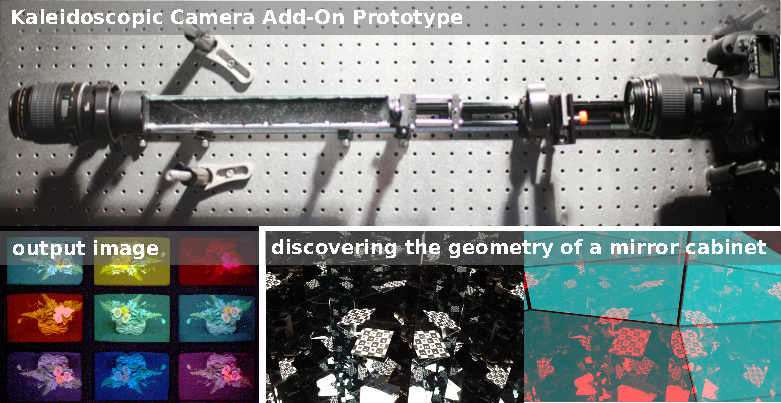Section: New Results
Axis 2: From Acquisition to Display
Interactive Spatial Augmented Reality
Participants: B. Ridel, P. Reuter, X. Granier
We propose the revealing flashlight [26] , a new interaction and visualization technique in spatial augmented reality that helps to reveal the details of cultural heritage artifacts (see Figure 3 ), since they often contain details that are difficult to distinguish due to aging effects such as erosion. We locally and interactively augment a physical artifact by projecting an expressive 3D visualization that highlights its features, based on an analysis of its previously acquired geometry at multiple scales.
Our novel interaction technique simulates and improves the behavior of a flashlight: according to 6-degree-of-freedom input, we adjust the numerous parameters involved in the expressive visualization - in addition to specifying the location to be augmented. This makes advanced 3D analysis accessible to the greater public with an everyday gesture, by naturally combining the inspection of the real object and the virtual object in a co-located interaction and visualization space. The revealing flashlight can be used by archeologists, for example, to help decipher inscriptions in eroded stones, or by museums to let visitors interactively discover the geometric details and meta-information of cultural artifacts. We confirm its effectiveness, ease-of-use and ease-of-learning in an initial preliminary user study and by the feedbacks of two public exhibitions.
High Dynamic Range, Multispectral, Polarization, and Light-Field Imaging
Participants: A. Manakov, J. Restrepo, R. Hegedüs, I. Ihrke
In [5] we propose a non-permanent add-on that enables plenoptic imaging with standard cameras (see also Figure 10 top and left). Our design is based on a physical copying mechanism that multiplies a sensor image into a number of identical copies that still carry the plenoptic information of interest. Via different optical filters, we can then recover the desired information. A minor modification of the design also allows for aperture sub-sampling and, hence, light-field imaging. As the filters in our design are exchangeable, a reconfiguration for different imaging purposes is possible. We show in a prototype setup that high dynamic range, multispectral, polarization, and light-field imaging can be achieved with our design.
|
Structure of a Planar Mirror System from Multiple Observations of a Single Point
Participants: I. Reshetouski, A. Manakov, I. Ihrke
We have investigated the problem of identifying the position of a viewer inside a room of planar mirrors with unknown geometry in conjunction with the room's shape parameters [25] (see also Figure 10 bottom right). We consider the observations to consist of angularly resolved depth measurements of a single scene point that is being observed via many multi-bounce interactions with the specular room geometry. Applications of this problem statement include areas such as calibration, acoustic echo cancelation and time-of-flight imaging. We theoretically analyze the problem and derive sufficient conditions for a combination of convex room geometry, observer, and scene point to be reconstructable. The resulting constructive algorithm is exponential in nature and, therefore, not directly applicable to practical scenarios.
To counter the situation, we propose theoretically devised geometric constraints that enable an efficient pruning of the solution space and develop a heuristic randomized search algorithm that uses these constraints to obtain an effective solution. We demonstrate the effectiveness of our algorithm on extensive simulations as well as in a challenging real-world calibration scenario.
Mirrors in Computer Graphics, Computer Vision and Time-of-Flight Imaging
Participants: I. Reshetouski, I. Ihrke
We have investigated the state of the art in dealing with the geometry of mirror systems [28] .
Mirroring is one of the fundamental light/surface interactions occurring in the real world. Surfaces often cause specular reflection, making it necessary to design robust geometry recovery algorithms for many practical situations. In these applications the specular nature of the surface is a challenge. On the other side, mirrors, with their unique reflective properties, can be used to improve our sensing modalities, enabling applications such as surround, stereo and light field imaging. In these scenarios the specular interactions are highly desirable. Both of these aspects, the utilization and circumvention of mirrors are present in a significant amount of publications in different scientific areas. These publications are covering a large number of different problem statements as well as many different approaches to solutions. In this survey we focused on a collection and classification of the work in this area.
Computational Fabrication and Display of Material Appearance
Participant: I. Ihrke
We have investigated the state of the art in digital material fabrication and active display technology [22] .
After decades of research on digital representations of material and object appearance, computer graphics has more recently turned to the problem of creating physical artifacts with controllable appearance characteristics.
While this work has mostly progressed in two parallel streams – display technologies as well as novel fabrication processes – we believe there is a large overlap and the potential for synergies between these two approaches. In this report, we summarize research efforts from the worlds of fabrication display, and categorize the different approaches into a common taxonomy. We believe that this report can serve as a basis for systematic exploration of the design space in future research.



